Super Mario Bros.: The Lost Levels is a video game released for the Family Computer Disk System, Game Boy Advance, and the Virtual Console. It is a sequel to Super Mario Bros. that, prior to Super Mario All-Stars and the Virtual Console release, was exclusive to Japan.
This game is known as simply Super Mario Bros. 2 in Japan. The reason for it being replaced by another game with the same name in the US (which was later re-released in Japan as "Super Mario USA") is that Nintendo of America thought it would be too hard for American audiences, and it was too much like the original Super Mario Bros.
Story[]
The story is the same as Super Mario Bros.: Bowser had kidnapped Princess Peach (then known as Princess Toadstool outside Japan), presumably turning the citizens of the Mushroom Kingdom into plants, blocks, etc. a second time. This time, Luigi can set out on his own to rescue Peach with his own distinct abilities.
If Mario or Luigi complete levels 1-1 through 8-4 without warping, he is transported to “Fantasy World”, world 9, with only one life, replaying those four levels until he dies.
Each time 8-4 is completed, a star is added to the title screen; after eight stars are earned, Mario or Luigi can play a second quest consisting of four new worlds, A through D. The story is the same as the first quest.
Characters[]
Playable[]
- Mario - After Mario learns that Bowser has captured the Princess again, he goes straight off to save her. He controls identically to Super Mario Bros.: He can jump far, run fast, and stop on a dime.
- Luigi - Luigi is similar to Mario, but jumps slightly higher, and has worse traction, making it seem like he is walking on ice. This is the first Mario game to give Luigi distinct jumping physics.
Non-playable[]
- Princess Toadstool - She is kidnapped by Bowser, and taken to his castle. Mario or Luigi will again have to go through 8 worlds to save her.
- Toad - Different Toads were captured and taken to the castles in worlds 1-7 and A-C for Mario or Luigi to save. They explain that Princess Peach is "in another castle," which led to a long-running joke throughout the series.
- Bowser - Bowser has taken control of the Mushroom Kingdom and kidnapped all of the residents other than Mario and Luigi. Now the brothers will have to defeat Bowser to bring back peace to the land.
- False Bowser - False Bowsers will appear at the end of every world other than 8, 9, and D. They are regular enemies with Bowser disguises on to fool you.
- Bowser's Brother - A blue Bowser that appears in 8-4, 9-3, and D-4. He acts as a "pre-Bowser" Bowser.
Enemies[]
- Poison Mushroom - Disguised as either a Super Mushroom or 1-up Mushroom, this Mushroom has the same effect as getting hit by any other enemy (i.e. if the player is Super Mario or Fire Mario, they revert to regular Mario; if the player is regular Mario, they die).
- Koopa Troopa - A turtle-like enemy that can be a projectile if jumped on first. There are two types of them, a green one and a red one. The green ones will walk off platforms while the red ones will turn around. If you jump on them, they will come back out of their shells after a few seconds.
- Koopa Paratroopa - A Koopa Troopa with wings that will jump extra high or fly in a straight line. Like the regular Koopas, these are either red or green. If stomped, they will lose their wings.
- Goomba - The most common enemy that will only try to run into you. They will sometimes attack in groups, where you will be able to kill them all while jumping once.
- Lakitu - Lakitus sit atop clouds while they throw Spinies at you. They can be stomped but often fly too high to easily reach.
- Spiny - Spinies are the enemies that Lakitus throw at you. They have spines on their backs, meaning that you cannot kill them by jumping on them. They can be defeated with a Koopa or Buzzy Beetle shell, fireball, or Super Star. They will also walk off ledges.
- Buzzy Beetle - A beetle that is like a Koopa Troopa, except the only way to destroy it is to knock it off an edge, hit it with a shell, or to ram into it while invincible.
- Piranha Plant - A carnivorous plant that will pop out of pipes trying to bite you. The green ones are identical to the ones in Super Mario Bros., and will stay in their pipe if Mario or Luigi are right next to it. This game introduces a new red variety that appears starting in World 4, which will continue to move in and out even with Mario or Luigi adjacent to their pipes.
- Bullet Bill - A bullet that will be shot out of a cannon toward you.
- Hammer Bros. - A pair of Koopa brothers that will throw hammers. They are often, but not always, found in pairs.
- Cheep Cheep - Found in all underwater levels, these fish will try to swim into you. In a few levels on land, they will jump high into the air and try to hit you. In land levels, they can be stomped.
- Blooper - A squid that will try to swim into you, or try to fly into you. This game introduces Bloopers that can fly in the air, which can be stomped.
- Podoboo - A fireball that will pop out of lava in castle levels.
List of levels[]
| World (As seen in SMBD) | Level | Setting | Enemies found (first appearance in bold) |
|---|---|---|---|
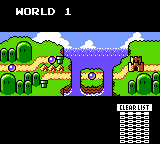 |
World 1 | Overworld | Goomba, Koopa Troopa (red and green), Koopa Paratroopa (red and Green), Piranha Plant (green) |
| World 1 | Underground | Goomba, Koopa Troopa, Piranha Plant, Buzzy Beetle | |
| World 1 | Athletic | Blooper, Koopa Troopa, Koopa Paratroopa | |
| World 1 | Castle | Firebar, Koopa Troopa, False Bowser (Imported as World 1-4 of Vs. Super Mario Bros.) | |
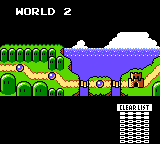 |
World 2 | Dark Overworld | Goomba, Koopa Troopa, Koopa Paratroopa, Piranha Plant |
| World 2 | Dark Overworld | Koopa Troopa, Koopa Paratroopa, Goomba, Piranha Plant (Imported as World 3-2 of Vs. Super Mario Bros.) | |
| World 2 | Dark Athletic | Jumping Cheep-Cheep, Koopa Troopa, Koopa Paratroopa, Blooper | |
| World 2 | Castle | Koopa Troopa, Goomba, Firebar, Podoboo, False Bowser | |
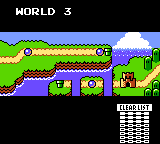 |
World 3 | Overworld | Hammer Bro., Koopa Troopa, Koopa Paratroopa, Bullet Bill, Piranha Plant |
| World 3 | Underwater | Blooper, Cheep-Cheep, Koopa Troopa, Koopa Paratroopa | |
| World 3 | Athletic | Koopa Troopa, Koopa Paratroopa, Piranha Plant | |
| World 3 | Castle | Firebar, Piranha Plant, False Bowser | |
 |
World 4 | Overworld | Piranha Plant (red), Lakitu, Spiny, Spiny Egg |
| World 4 | Overworld | Koopa Troopa, Piranha Plant, Buzzy Beetle, Lakitu, Spiny, Spiny Egg, Goomba | |
| World 4 | Athletic | Koopa Paratroopa, Bullet Bill (Imported as World 6-3 of Vs. Super Mario Bros.) | |
| World 4 | Castle | Firebar, Goomba, Koopa Troopa, Hammer Bro., Piranha Plant, Podoboo, False Bowser | |
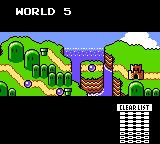 |
World 5 | Overworld | Buzzy Beetle, Piranha Plant, Koopa Troopa, Koopa Paratroopa, Goomba |
| World 5 | Underground | Piranha Plant, Goomba, Koopa Troopa, Buzzy Beetle | |
| World 5 | Athletic | Koopa Paratroopa, Piranha Plant, Bullet Bill, Blooper | |
| World 5 | Castle | Podoboo, Firebar, False Bowser (Imported as World 6-4 of Vs. Super Mario Bros.) | |
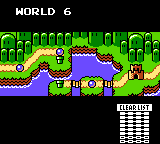 |
World 6 | Overworld | Piranha Plant, Buzzy Beetle, Koopa Troopa, Koopa Paratroopa, Goomba, Bullet Bill, Hammer Bro. |
| World 6 | Underwater | Blooper, Cheep-Cheep, Koopa Troopa, Koopa Paratroopa (Imported as World 7-2 of Vs. Super Mario Bros.) | |
| World 6 | Athletic | Koopa Troopa, Koopa Paratroopa, Cheep-Cheep (Imported as World 7-3 of Vs. Super Mario Bros.) | |
| World 6 | Castle | Podoboo, Firebar, Piranha Plant, Hammer Bro., False Bowser | |
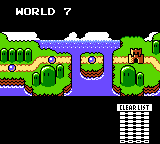 |
World 7 | Dark Overworld | Koopa Troopa, Koopa Paratroopa, Piranha Plant, Hammer Bro., Bullet Bill |
| World 7 | Dark Overworld | Blooper, Cheep-Cheep, Piranha Plant | |
| World 7 | Dark Athletic | Jumping Cheep-Cheep, Koopa Troopa, Koopa Paratroopa | |
| World 7 | Castle | Podoboo, Firebar, False Bowser | |
 |
World 8 | Overworld | Goomba, Koopa Troopa, Koopa Paratroopa, Piranha Plant, Buzzy Beetle |
| World 8 | Overworld | Goomba, Koopa Paratroopa, Piranha Plant, Buzzy Beetle, Lakitu, Spiny, Bullet Bill | |
| World 8 | Athletic | Koopa Troopa, Koopa Paratroopa, Piranha Plant, Bullet Bill, Hammer Bro. | |
| World 8 | Castle | Goomba, Koopa Paratroopa, Piranha Plant, Firebar, Podoboo, Buzzy Beetle, Hammer Bro., Blooper, Cheep-Cheep, False Bowser, Bowser | |
| World 9 | Underwater | Piranha Plant, Koopa Paratroopa, Bullet Bill, Lakitu, Spiny, Hammer Bro., Blooper, Buzzy Beetle | |
| World 9 | Underwater | Piranha Plant, Lakitu, Spiny | |
| World 9 | Overworld | False Bowser, Bowser | |
| World 9 | Underwater | Goomba, Koopa Troopa, Buzzy Beetle, Koopa Paratroopa, Hammer Bro., Blooper, Podoboo | |
 |
World A | Overworld | Koopa Troopa, Koopa Paratroopa, Piranha Plant, Hammer Bro. |
| World A | Underground | Piranha Plant, Hammer Bro., Bullet Bill | |
| World A | Athletic | Jumping Cheep-Cheep, Blooper, Koopa Paratroopa | |
| World A | Castle | Firebar, Podoboo, Koopa Troopa, Bullet Bill, False Bowser | |
 |
World B | Overworld | Buzzy Beetle, Koopa Troopa, Piranha Plant, Koopa Paratroopa |
| World B | Underwater | Blooper, Cheep-Cheep, Koopa Paratroopa, Koopa Troopa, Firebar, Piranha Plant | |
| World B | Athletic | Koopa Paratroopa, Piranha Plant, Bullet Bill, Koopa Troopa | |
| World B | Castle | Piranha Plant, Firebar, False Bowser | |
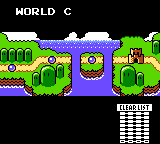 |
World C | Dark Overworld | Koopa Paratroopa, Piranha Plant, Hammer Bro., Buzzy Beetle |
| World C | Dark Athletic | Koopa Paratroopa, Jumping Cheep-Cheep, Blooper, Koopa Troopa, Bullet Bill | |
| World C | Dark Athletic | Lakitu, Spiny, Koopa Paratroopa, Piranha Plant, Firebar | |
| World C | Castle | Firebar, Koopa Troopa, Buzzy Beetle, Podoboo, False Bowser | |
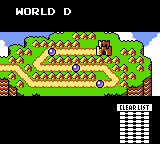 |
World D | Overworld | Hammer Bro., Koopa Paratroopa, Bullet Bill, Buzzy Beetle, Koopa Troopa, Piranha Plant |
| World D | Overworld | Koopa Troopa, Buzzy Beetle, Koopa Troopa, Piranha Plant, Bullet Bill | |
| World D | Overworld | Bullet Bill, Piranha Plant, Hammer Bro., Koopa Paratroopa | |
| World D | Castle | Piranha Plant, Firebar, Podoboo, Koopa Paratroopa, Jumping Cheep-Cheep, Hammer Bro., Blooper, False Bowser, Bowser [(Boss)(SNES remake)] |
Secret Worlds[]
There are five secret worlds: World 9, World A, World B, World C, and World D. World 9 can be unlocked by beating worlds 1-8 without warp zones. When world 8-4 is completed, a star is added to the title screen; if there are at least eight stars, holding A then pressing start will start a second quest beginning in World A and ending with World D.
Minus World[]
There is no legitimate method of accessing “Minus World” (actually world 36-1) in The Lost Levels.
Remakes[]
The first appearance of the game outside of Japan was in remastered form in Super Mario All-Stars for the Super Nintendo Entertainment System. Some level designs were slightly modified to be made a bit easier, additional checkpoints and 1-ups were added, and poison mushrooms were altered to appear less similar to super mushrooms. A save feature was also added to allow starting the game from any accessed level.
The original Family Computer Disk System version was finally released much later on Wii's Virtual Console. Outside of Japan it was labeled an “import” and cost 100 Wii Points more than NES titles. The title also appears in Nintendo Entertainment System Online for Nintendo Switch in its original unaltered form for Nintendo Switch Online subscribers.
The game appeared as an unlockable in Super Mario Bros. Deluxe for Game Boy Color titled Super Mario Bros. for Super Players. It can be unlocked by scoring at least 300,000 points in the main Super Mario Bros.. The remake of Super Mario Bros.: The Lost Levels notably removed Worlds 9 to D as well as wind in levels. Some levels were further altered to accommodate the Game Boy Color's smaller screen.
The original game was also released in all regions in a special 35th anniversary edition Super Mario Bros. Game & Watch mini-console. The title screen has been modified to allow starting from any accessed world (except world 9), high score retention, addition of a 2020 copyright date, and starting with infinite lives, but the game itself is original.
Reception[]
At the time of its release, The Lost Levels topped Famicom Tsūshin's charts.[1] The game was the most popular game on the Disk System, for which it sold about 2.5 million copies.[2] Retrospective critics viewed The Lost Levels as an expansion of the original,[3][2][4][5] akin to extra challenge levels tacked on its end.[3] Despite their similarities, the sequel is distinguished by its notorious difficulty.[6] 1001 Video Games You Must Play Before You Die summarized the game as both "familiar and mysterious" and "simply rather unfair".[7] The Lost Levels replaced the original's accessible level designs with "insanely tough obstacle courses"[8] as if designed to intentionally frustrate and punish players beginning with its first poison mushroom.[9][6][3]
Retrospective reviewers recommended the game for those who mastered the original, or those who would appreciate a painful challenge.[6][5][10] Casual Mario fans, GameZone wrote, would not find much to enjoy.[10] Nintendo Life's reviewer felt that while the original was designed for recklessness, its sequel taught patience, and despite its difficulty, remained both "fiendishly clever" and fun.[6] On the other hand, GamesRadar felt that the game was an unoriginal, boring retread, and apart from its "pointlessly cruel" difficulty, not worthy of the player's time.[11] GamesRadar and IGN agreed with Nintendo of America's choice against releasing the harder game in the 1980s,[11][3] though Eurogamer thought that The Lost Levels was "technically a much better game" than the Doki Doki Panic-based Super Mario Bros. 2 the American market received instead.[5]
The Lost Levels is remembered among the most difficult games by Nintendo and in the video game medium. Three decades after the game's release, Kotaku wrote that the demanding player precision required in The Lost Levels made fast playthroughs (speedruns) "remarkably fun" to spectate. NES Remix 2 (2014), a compilation for the Wii U, similarly segmented The Lost Levels into speedrun challenges, which made the challenging gameplay more palatable. Many years after the release of The Lost Levels, fans of the series would modify Mario games to challenge each other with nearly impossible levels. The challenges of The Lost Levels presaged this Kaizo community, and according to IGN, The Lost Levels shares more in common with this subculture than with the Mario series itself. Indeed, the sequel is remembered as a black sheep in the franchise and a reminder of imbalanced gameplay in Nintendo's history.
Luigi received his first distinctive character traits in The Lost Levels: less ground friction, and the ability to jump farther. IGN considered this change to be the game's most significant, though the controls remained "cramped" and "crippled" with either character. The game's poison mushroom item, with its character-impairing effects, became a staple of the Mario franchise. Some of the Lost Levels appeared in a 1986 promotional release of Super Mario Bros., in which Nintendo modified in-game assets to fit themes from the Japanese radio show All Night Nippon. Journalists have ranked The Lost Levels among the least important in the Mario series and of Nintendo's top games.
Trivia[]
- The game is referenced by Huey in Paper Mario: Color Splash.
Gallery[]
External links[]
References[]
- ↑ Irwin, Jon (October 6, 2014). Super Mario Bros. 2. Los Angeles: Boss Fight Books. pp. 22–29. ISBN 978-1-940535-05-0.
- ↑ 2.0 2.1 "Super Mario Bros. 2". Atari HQ. May 4, 1999. Archived from the original on March 11, 2015. Retrieved April 1, 2015.
- ↑ 3.0 3.1 3.2 3.3 Thomas, Lucas M. (October 3, 2007). "Super Mario Bros.: The Lost Levels Review". IGN. Archived from the original on May 16, 2022. Retrieved June 2, 2022.
- ↑ Miller, Skyler. "Super Mario Bros. 2". AllGame. Archived from the original on November 14, 2014. Retrieved April 1, 2015.
- ↑ 5.0 5.1 5.2 Whitehead, Dan (September 15, 2007). "Virtual Console Roundup". Eurogamer. Archived from the original on October 4, 2021. Retrieved June 1, 2022.
- ↑ 6.0 6.1 6.2 6.3 Hughes, Robert (January 31, 2014). "Super Mario Bros.: The Lost Levels (Wii U eShop / NES) Review". Nintendo Life. Archived from the original on May 10, 2022. Retrieved June 2, 2022.
- ↑ Donlan, Christian (2010). "Super Mario Bros.: The Lost Levels". In Mott, Tony (ed.). 1001 Video Games You Must Play Before You Die. New York: Universe. p. 129. ISBN 978-0-7893-2090-2. OCLC 754142901.
- ↑ McLaughlin, Rus (September 13, 2010). "IGN Presents: The History of Super Mario Bros". IGN. Archived from the original on March 20, 202. Retrieved June 1, 2022.
- ↑ "The Top 125 Nintendo Games of All Time". IGN. September 24, 2014. Archived from the original on April 21, 2022. Retrieved June 1, 2022.
- ↑ 10.0 10.1 Sanchez, David (January 2, 2012). "Super Mario Bros.: The Lost Levels - Does It Hold Up?". GameZone. Archived from the original on January 20, 2015. Retrieved March 26, 2017.
- ↑ 11.0 11.1 Gilbert, Henry (December 28, 2011). "Why every Mario game is the best AND worst in the series". GamesRadar. Archived from the original on April 7, 2016. Retrieved May 31, 2017.
[]
 / / | ||
|---|---|---|
| Nintendo Entertainment System / Family Computer games | ||
| Dr. Mario • Donkey Kong • Donkey Kong 3 • Donkey Kong Classics • Donkey Kong Jr. • Donkey Kong Jr. + Jr. Math Lesson • Donkey Kong Jr. Math • Golf • Mario Bros. • Mario is Missing! • Mario's Time Machine • NES Open Tournament Golf • Nintendo World Championships 1990 • Pinball • Super Mario Bros. • Super Mario Bros. 2 • Super Mario Bros. 3 • Wario's Woods • Wrecking Crew • Yoshi • Yoshi's Cookie | ||
| Family Computer Disk System games | ||
| All Night Nippon: Super Mario Bros. • Famicom Grand Prix: F-1 Race • Famicom Grand Prix II: 3D Hot Rally • Family Computer Golf: Japan Course • Family Computer Golf: U.S. Course • I Am a Teacher: Super Mario no Sweater • Kaettekita Mario Bros. • Super Mario Bros.: The Lost Levels • Yume Kōjō: Doki Doki Panic | ||



